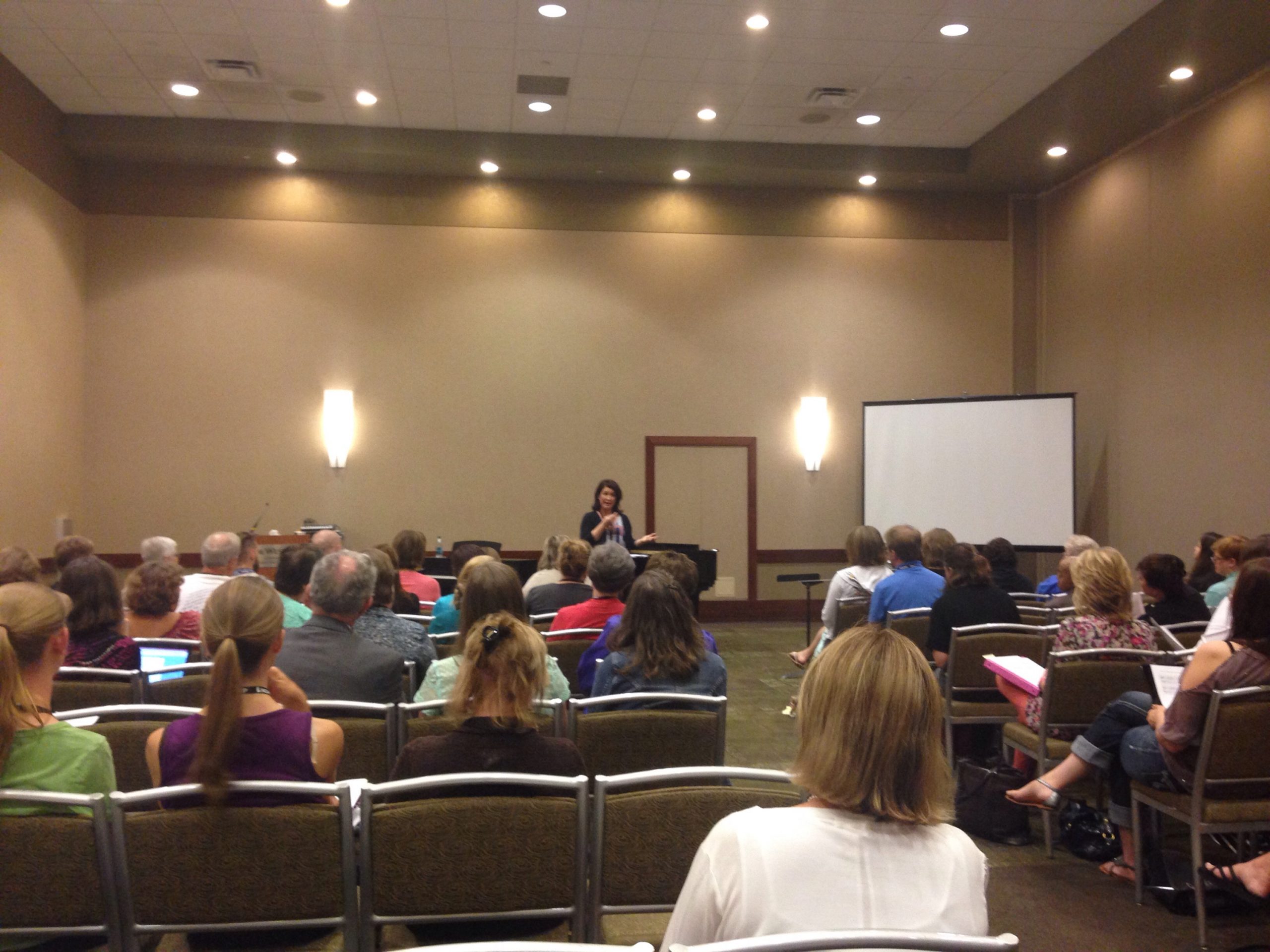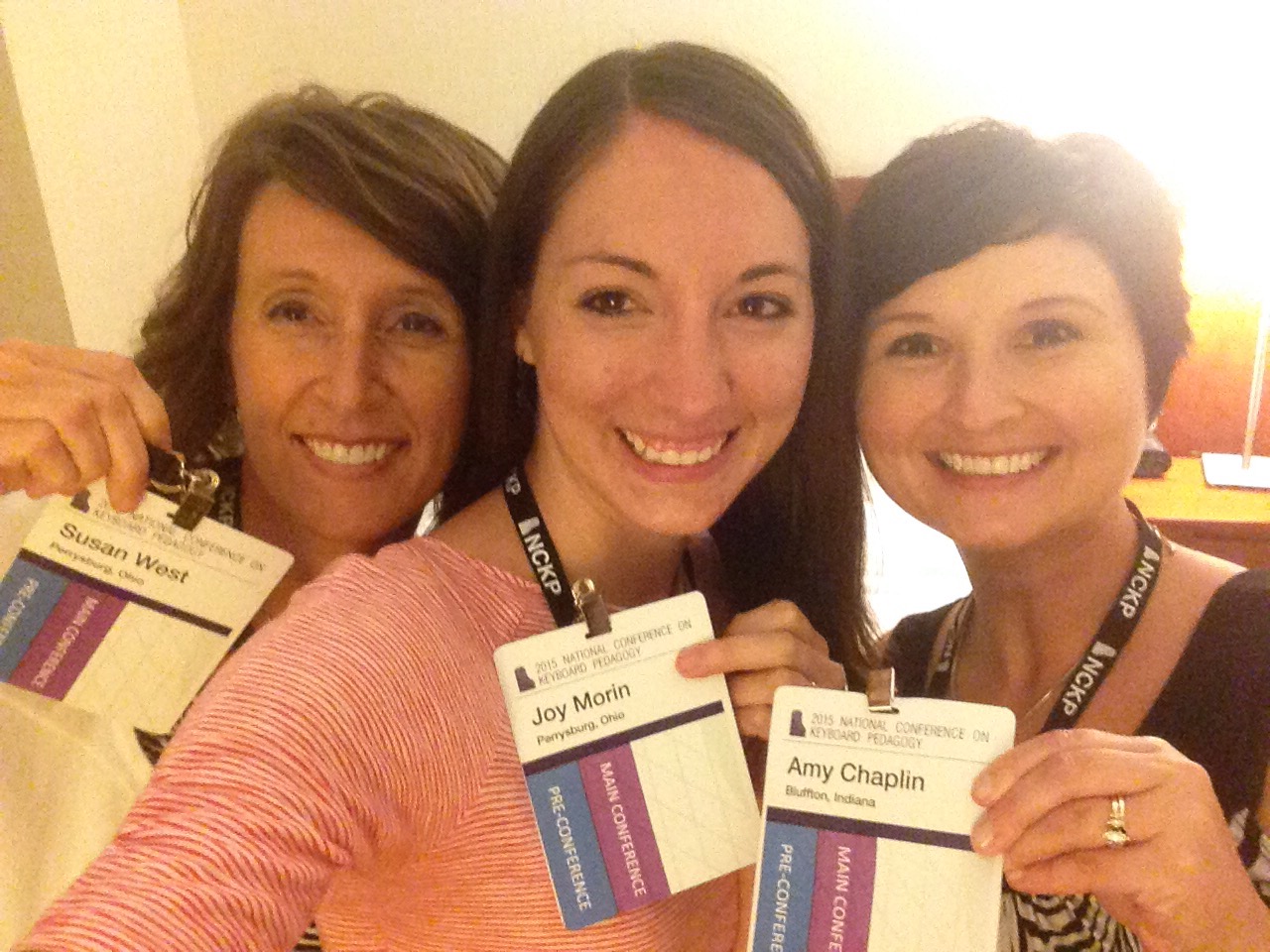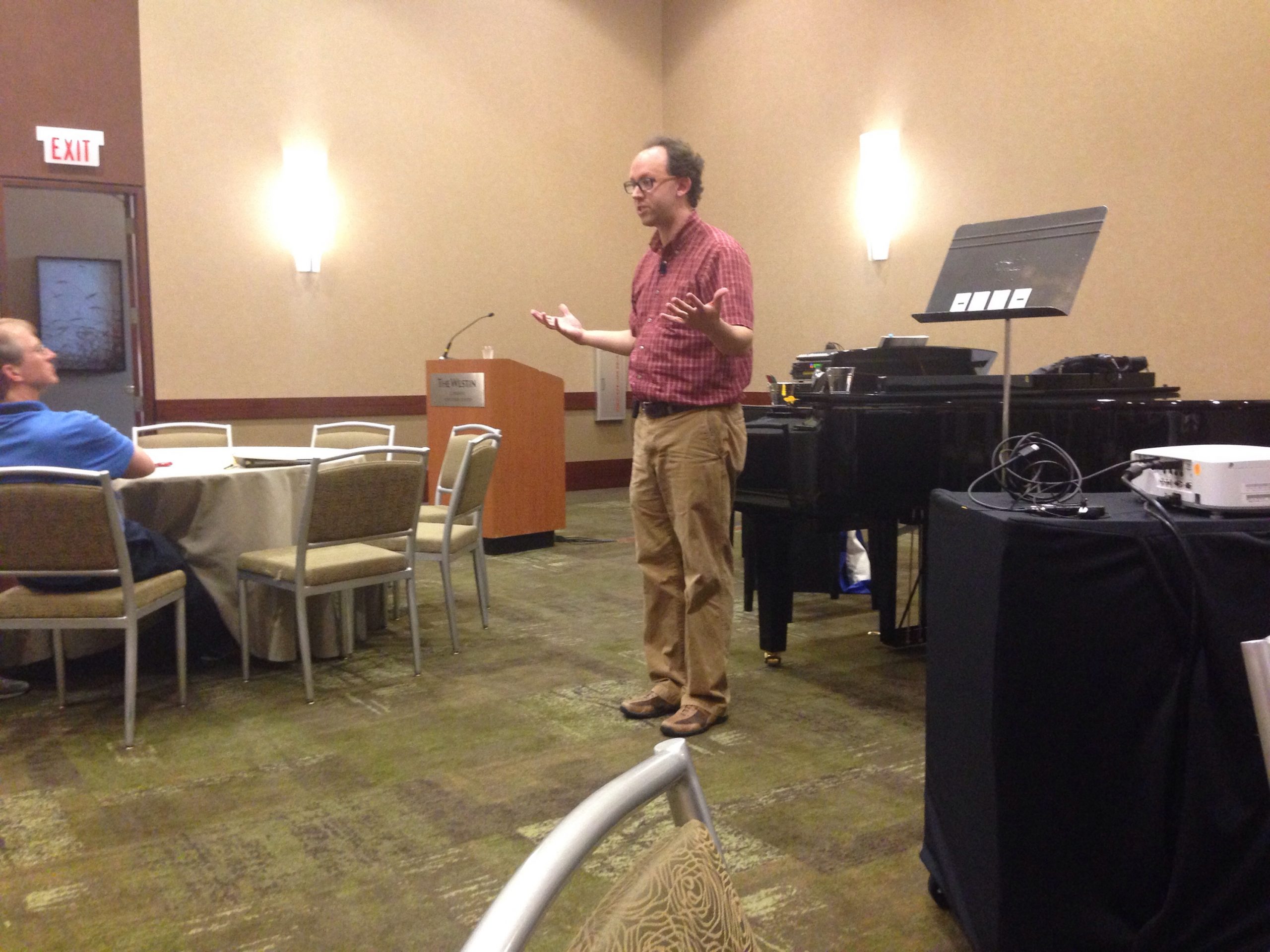Today, I traveled with my good friend Susan West to Lombard, Illinois to attend the 2015 National Conference on Keyboard Pedagogy! When we arrived, we met up with our other roommate, Amy Chaplin.
We attended the Independent Music Teachers track of the Pre Conference Seminars.
1:30: Marvin Blickenstaff – Keynote Address: The Many Faces of Music
In his wonderful and inspiring keynote for the day, Marvin discussed the many faces of music.
1. Music as Entertainment. We think of Haydn and Mozart as examples as those who composed music for entertainment purposes. But do we teach to entertain? Do we ask students that we choose repertoire for entertainment? Or musical growth and non musical values?
2. Music as Service. Music touches our soul and allows us to experience beauty. “The human soul needs music more than bread.”as teachers, are dedicated to the improvement of the lives of those around us through music. Our students can also use music as service: playing for nursing homes, etc. everyone has a need for music.
3. Music as Self-Expression. Why do we study? To explore the rich sounds of the great masters. As Richard Chronister once said (paraphrased): “Students take lessons for one reason: to learn to make exciting sounds at the piano. Every lesson that does not help this goal is cultivating a potential dropout.” We must remember to ask: “how does this piece make you feel? What is Kuhlau trying to say through this passage?” This should be the central goal of our lesson: to unlock expression in every piece.
4. Music as Education. Music training has great impact on brain development as well as emotional health and development. Music brings together the physical, emotional, and intellectual. Music education is an important part of holistic education.
5. Music as Art. There is artistry in every child. The goal of teaching is to produce artists. Those who feel and express beyond the page. We do not teach to entertain, we teach to give students the experience of expression and artistry. We live for those moments when listeners say that the music touches or speak to them. Even a beginner can achieve this, we can agree. Even our youngest students can play with great focus, sincerely, and artistry. When you hear it, you know it. For a moment, you are changed because the music has taken over your sensibilities.
What constitutes artistic students? Accuracy is not artistry. An artist looks behind the notes. All music expresses some aspect of the human emotion. Do you feel the sounds? What do you wish your listeners to feel? Dynamics, balance, and breath are the main three sounds that Marvin suggests make up artistry.
Music has many faces. We with our students engage in this faces together. But we do our students a disservice if we do not limit our instruction to entertainment, but to treat every student as an artist.
2:15 Pete Jutras – What Are We Really Teaching?
In his talk, Pete Jutras discussed a holistic approach to piano teaching, where elements such as ear training, rhythm, sigh-reading, and theory are approached and taught through the very repertoire the student is learning instead of necessarily through separate books or activities. Our natural responses to music centers on whole structures, so this approach to teaching makes sense. He encouraged us not to Let’s not use sight of the wholeness of music.
3. How do we fit it all in? Start with music.
Music for music’s sake. Instead of fragmenting ear training, theory, improvisation, etc during the lesson, keep it altogether. Spent 20 minutes on a really great piece and then dive into the harmony, some ear playback, improvising a different LH, etc. Keep things in context for the student.
There are ways to sequence from the music instead of depending on the leveled theory or ear training books.
How do we fit it all in? Remember what musicianship means: beauty, understanding, meet students where they are. Good teaching is not the imposition of the teacher’s will onto the student. Help them experience the joy of music.
Frances Clark said we are first teachers of the student, second the music, and third the piano.
Goal: integrate back into the music.
W 3:00 Arlene Steffan – Puzzle Pieces: Efficient and Effective Lesson Planning
What can lesson planning do for my students?
To keep the big picture in mind for where you are going. The student knows that the plan for the lesson is not entirely up to what they do. You already have things ready.
Goal of planning: the student should feel empowered. Goals affect how we plan.
Well rounded musician is aware, learns how to hear, capable of expression. Some student have never been asked for their opinion about the music. But they should have the opportunity for self-expression. Creativity is the fourth element. Creativity is fifth is exhibit understanding – could be through reading skills, theory skills (apply!), etc.
List your priorities.
Arlene described a current 9 year old student. She sits down and plans some goals for the year. For example: finish Music Tree 3, improve facility (speed and coordination), increase chord recognition, increase confidence. This can be broken down into semester goals: master 16th notes and triads and inversions (C G and D and their relative minors).
Arlene then talked about possible ways to introduce a new pieces and having a plan for the mood, sound, and feeling the piece. Part of the lesson plan is considering what kinds of things we can talk about when introducing a new piece.
4:00 Richard VanDyke: Five Guiding Principles for the Technical Development of the Advancing Pianist
Objective:
Provide a general overview of great technique
Utilize the Five Guiding Principles I your student’s lesson plan
Develop a game plan to perform landmark repertoire
Meeting student/parent expectations:
Plan immediately with minimal practice
Facility
Etc
The principles are:
Touch, sound, rhythm, facility, balance.
We start with sound. Produce big sounds (thunderstorm) and soft sounds. How do we sit at the keyboard? Rhythm work begins immediately. Facility and balance come somewhat later. All five stages must be worked on constantly with students.
The Principle of Touch
Physical Mechanics – very individualistic. Consider Glenn Gould, Horowitz, Lang Lang, Andreas Schiff, Angela Hewitt.
Hand Position – hands vary, but firm fingertips are nearly universal. Alicia del la Rocha
Posture – feet planted, alignment from shoulders to hips. Dame Myra Haas
Coordinating
The Principle of Sound
The art of listening
Articulation – staccato, legato, and later portato, sforzando, and accents
Dynamic contrasts –
Listening
Principle of Rhythm
Pulse – use syllables while clapping the pulse (Kodaly)
Tempo
Notation
Phrasing
The Principles of Facility
Fluidity and Speed – warm up exercises, scales/arpeggios, technical studies. Start slow and focus on firm fingertips. Speed comes later.
Choreography
Navigating the Keyboard – graded études (Celebration Series) and later, concert études (Moszkowski Op. 72 is great especially because they work both hands, Hamlin études are very interesting).
Consistency – repetition
Principle of Balance
Analysis – form, structure, finding the subject, cadences
Voicing – prioritizing various voices
Control – applying more weight to the dominant voice
Shaping –
Evaluate your students (see handout)
Use to track progress from year to year and project goals for future years.
*peice: The Little Lead General by David Carr Glover
5:00 Elissa Milne: Repertoire Recipes

Elissa looked at the “ingredients” of pieces of music and evaluated the music in terms of its boring-ness. The ingredient list for the anonymous “Bagpipe” teaching piece.
What could we do with the ingredient of the 5th in the LH? Broken, grace note, move the fifth (mixolydian mode), inverting, etc. what if we changed it to ternary form instead of binary form? There are many possibilities. Instead of focusing on achieving accuracy, we want our students to think like chefs: what are the sound possibilities here?
The next piece is “Chase” by Elissa Milne. This piece can be taught learning the odd measures first and then the even measures. During the missing measures, students could make up their own thing. Could be a teacher duet improv activity.
We can ask the student: What other ingredients could be changed? What if we didn’t do the repeated note?
Next, we messed with the ingredients of the Musette from the Anna Magdalena Notebook. Change the LH to a fifth instead of an octave. Change the mode from major to Phrygian or a flat two. Take out the third eighth note. How do these changes affect the experience of the hand and the sound – and therefore affect the heart’s response.
Next was “La Columbe” (The Dove) by Oliver Messiaen, an early advanced piece.
Many of these displacements can happen before you even show them the music. Teach the music away from the page. We too often start with the sheet music, instead of starting with the sound, the feel, or the emotion. We send a message to our students that music is about following directions instead or with ingredients. Ingredients allows them to cook their own
to open the pod and smash it up. Familiarity with the ingredients is key. Eggs are so fun to cook – there are so many ways to prepare it. But our students think it is about making it hard boiled. Hard boiled egg piano teaching is preparing 6-8 pieces a year for competition or exams.
Our students often see things but see a couple of ingredients on the page that they don’t know, and don’t want to order it. When you hear it, you think one thing, but when you see it, you think another. Elissa has given up on letting students see the score when playing a piece for them. She demonstrated her piece Salt and Pepper, which is a black key piece with changing time signatures and many accidentally. These things can cause teachers to avoid teaching a piece that is physically easy.
This kind of ingredient changing must start from the very beginning. Even Hot Cross Buns. Transpose it to E major for RH or Db for the LH. What if we do staccato versus legato. How about tempo? Can’t there be many different possibilities? When we make change, we must make sure they know why (and it’s not because it is “right” – but because of what expression it might create).
Posture and hand is not about getting it right. It is about learning to be aware of body differences. Ask: how does it feel when your body is in this position? Try it with shoulders back and forward (how does it feel? What is your emotional response?). Students are unable to differentiate until they explore the range of motion possibilities.
What to do when a student responds “I don’t know” to these kinds of questions. Some students don’t have an opinion. We need to help students learn how to have an opinion. You cannot be a musician without an opinion. Break it down to opinions that are not scary. Give choices and if they say I don’t know, say, try both.
7:30 Jason Sifford – Manipulation Stations
Related Posts:
from Color In My Piano http://colorinmypiano.com/2015/07/30/nckp-2015-1-wednesday-preconference-seminars/




No comments:
Post a Comment